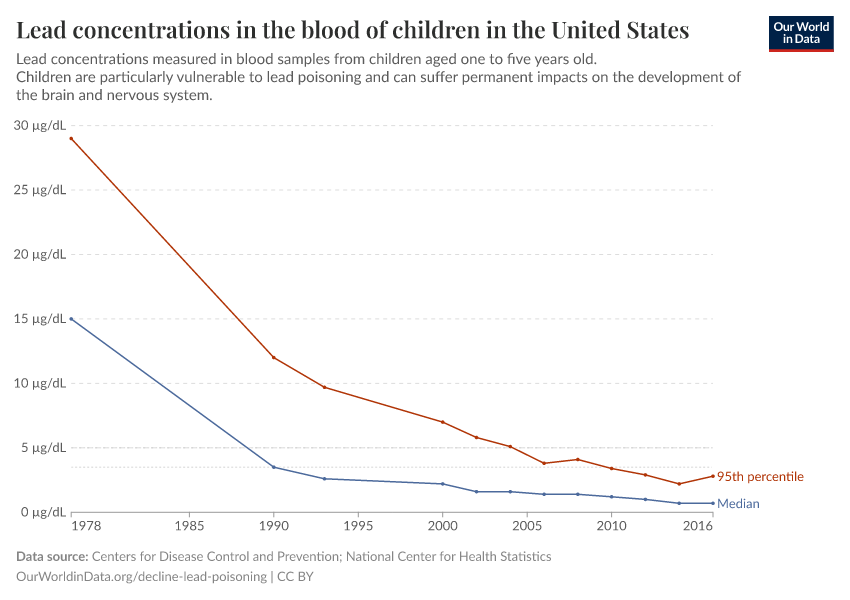Many countries have achieved an impressive reduction in lead poisoning
The phase out of leaded gasoline, and regulations on leaded paints and pipes has led to a dramatic reduction in lead poisoning across many countries.
Lead is an invisible pollutant. But one that is toxic to human health, and has large impacts on cognitive function, learning and decision-making. It’s particularly harmful when children are exposed at a young age – these impacts can be irreversible.
Thankfully many countries have made great progress against lead pollution. In the chart we see the decline in lead concentrations in the blood of children in the United States. This dates from the late 1970s onwards.
In 1978, the average concentration in children aged one-to-five years old was 15 µg/dL. Today the US CDC sets a target threshold for every child to have concentrations lower than 3.5 µg/dL. So, average concentrations were more than four times above acceptable levels. And some children had exposure levels up to 30 µg/dL – more than eight times too high.
This means most children in the US in the 1970s were suffering from lead poisoning.
But since then we have seen an impressive decline. By far the biggest impact was the phase-out of leaded gasoline through the 1970s and 1980s. This was the largest source of lead. By 1990, average levels were below 5 µg/dL (although some children were still exposed to levels well above 10 µg/dL).
This decline continued by tackling other common sources of lead; the primary focus of efforts since then has been on eliminating lead from paints used in households. By 2016, the median level was just 0.7 µg/dL – a 95% decrease from 1978.
This progress has been mirrored across the world. By 2021, every country in the world had phased out leaded gasoline in road vehicles. This means many will have seen the impressive drop in lead pollution that we see for the US.1
Yet, in many low-to-middle income countries, other sources of this toxin remain. To make sure this progress continues we need to eliminate lead in products such as paints, pipes, and improve the management of electronic waste.

Keep reading at Our World in Data
Endnotes
We see this in data in Germany, for example.
Hagner, C. (1999). Historical review of European gasoline lead content regulations and their impact on German industrial markets.
Cite this work
Our articles and data visualizations rely on work from many different people and organizations. When citing this article, please also cite the underlying data sources. This article can be cited as:
Hannah Ritchie (2022) - “Many countries have achieved an impressive reduction in lead poisoning” Published online at OurWorldinData.org. Retrieved from: 'https://archive.ourworldindata.org/20251125-173858/decline-lead-poisoning.html' [Online Resource] (archived on November 25, 2025).BibTeX citation
@article{owid-decline-lead-poisoning,
author = {Hannah Ritchie},
title = {Many countries have achieved an impressive reduction in lead poisoning},
journal = {Our World in Data},
year = {2022},
note = {https://archive.ourworldindata.org/20251125-173858/decline-lead-poisoning.html}
}Reuse this work freely
All visualizations, data, and code produced by Our World in Data are completely open access under the Creative Commons BY license. You have the permission to use, distribute, and reproduce these in any medium, provided the source and authors are credited.
The data produced by third parties and made available by Our World in Data is subject to the license terms from the original third-party authors. We will always indicate the original source of the data in our documentation, so you should always check the license of any such third-party data before use and redistribution.
All of our charts can be embedded in any site.